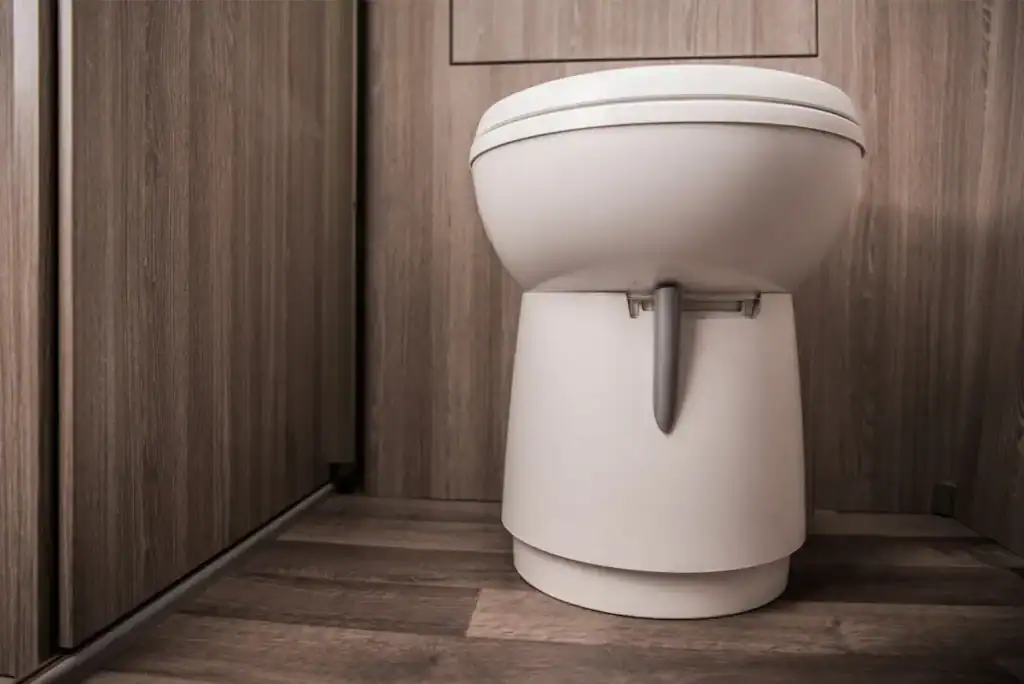Choosing the best composting toilet is a crucial step for those looking to reduce their ecological footprint and embrace a more sustainable lifestyle. This comprehensive guide will delve into the myriad of benefits these eco-friendly alternatives offer, from minimizing water use to easing the strain on sewage systems.
With careful consideration, a composting toilet can be a practical and environmentally responsible choice for both rural and urban dwellers alike. As we explore the top composting toilets on the market, we’ll highlight the key features that set each model apart, ensuring you’re well-equipped to select the perfect fit for your needs.
Stay tuned to understand how composting toilets can revolutionize your approach to waste management and help you contribute positively to the environment.
Benefits of Composting Toilets
Composting toilets offer a multitude of advantages, especially for those in remote locations with limited access to dump stations. By converting human waste into useful compost, these innovative toilet systems eliminate the need for conventional sewage smell and provide off-grid capability, paving the way for a more self-sufficient and eco-conscious way of life.
1. Environmentally Friendly
Composting toilets are a triumph of green design, turning waste into a resource without polluting waterways. By mimicking nature’s own method of breaking down organic matter, these systems help close the loop on waste, converting it into nutrient-rich compost that can enrich the soil and reduce the need for chemical fertilizers, thereby promoting a healthier ecosystem.
2. Off-Grid Capability
For those living off the grid or enjoying a nomadic lifestyle, composting toilets are an invaluable asset. They do not require a connection to sewer lines or septic systems, offering independence and flexibility.
By facilitating responsible waste management in even the most remote locations, composting toilets ensure that your environmental ethics need not be compromised by your choice of habitat.
3. Odor Control
Effective odor control is a critical aspect of compost toilets. The use of peat moss, bulking agents, and a urine-diverting design work together to facilitate the decomposition process and minimize foul odors. By separating liquid waste and allowing proper aeration within the compost pile, these toilet systems prove that ecological responsibility need not be a sensory sacrifice.
4. Low Maintenance
Unlike traditional toilet systems, composting toilets require minimal upkeep. With no intricate plumbing involved and fewer moving parts, these systems are less prone to malfunctions.
This simplicity ensures that maintaining a hygienic and operational composting toilet is a task well within reach for the average user, ensuring consistent performance with little to no hassle.
Top Picks for Best Composting Toilets
Here are the top picks for the best composting toilets on the market:
1. Nature’s Head Dry Composting Toilet: Leading the Pack
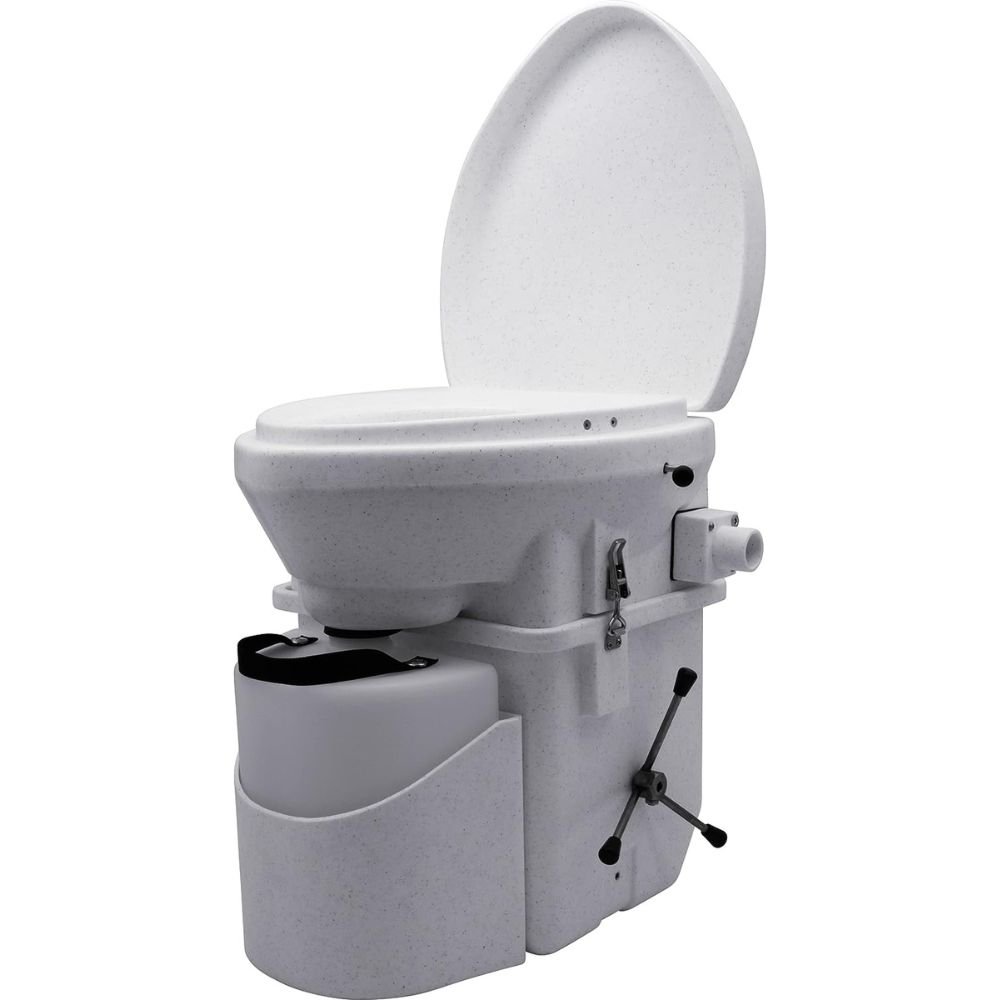
The Nature’s Head Dry Composting Toilet is widely regarded as the best compact composting toilet on the market for tiny houses and those seeking an eco-friendly waste disposal solution. Praised for its robust design and exceptional customer service, this toilet system is a standout choice for both novice and seasoned composting toilet users.
Key Features
- Urine-Diverting Feature: Nature’s Head composting toilet excels with its urine-diverting feature that separates liquid from solid waste, facilitating a more efficient composting process.
- Durable: Its stainless steel hardware and a vent hose ensure durability and proper aeration, while the inclusion of peat moss as a bulking agent helps to accelerate the decomposition process. The compost pile within the unit is easy to manage, and the urine bottle is conveniently sized for simple waste disposal.
- User-Friendly: Designed to be user-friendly, the toilet offers a straightforward installation process, making it accessible to a wide range of users. Its compact size makes it a perfect fit for tiny houses and other small living spaces, while the x20 magnification applied to its efficient use of space is a testament to the intelligent design of this composting toilet.
- Convenient: With a focus on convenience, the Nature’s Head composting toilet also includes a hand crank agitator for easy mixing of solid waste, ensuring optimal composting conditions. The thoughtful engineering behind this toilet system demonstrates a commitment to providing a practical and sustainable alternative to traditional toilets on the market.
Pros
- Effective separation of liquid and solid waste
- Durable stainless steel construction
- Easy to install and maintain
- Excellent customer service
Cons
- Higher upfront cost compared to other models
- Manual emptying of the compost pile required
2. Separett Villa: Sleek and Modern Design
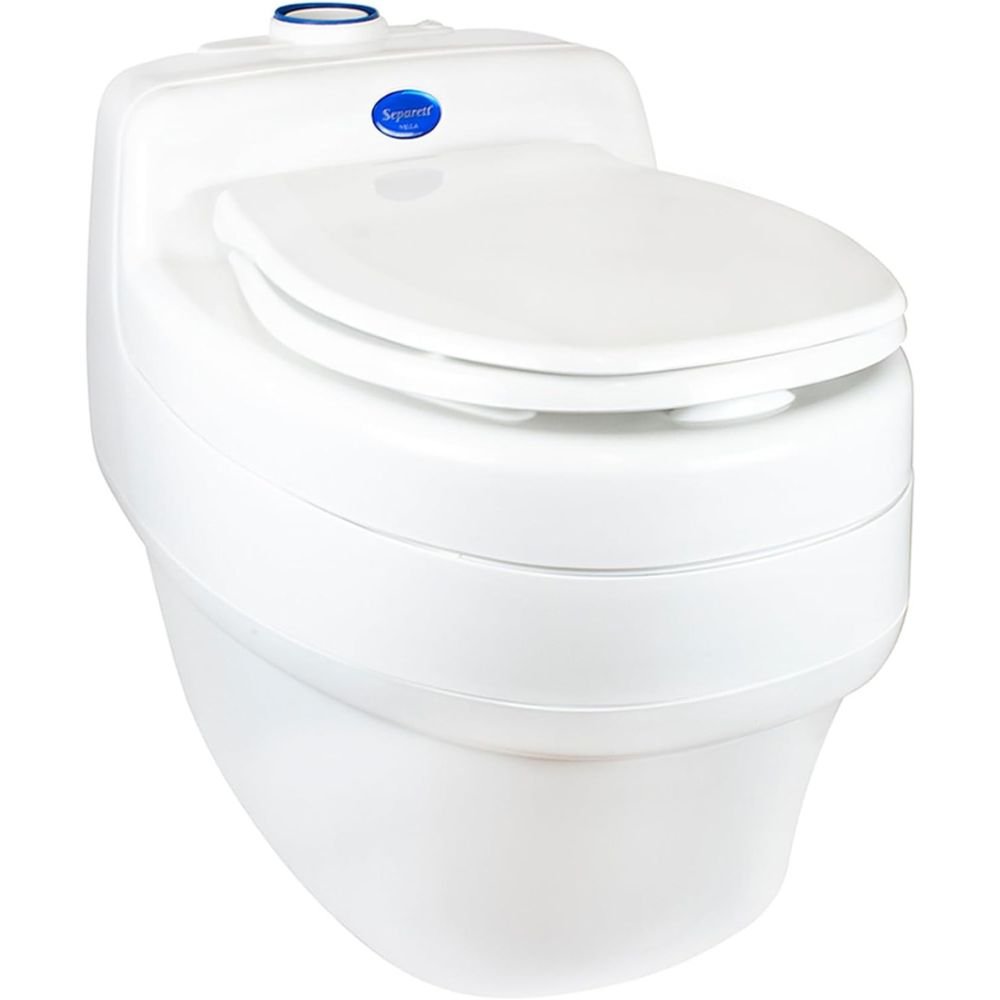
The Separett Villa stands out with its sleek, modern design, offering a comfortable and visually appealing alternative to a traditional toilet. Its innovative features make it a top choice for tiny houses and those seeking an eco-conscious composting solution. The Separett composting system combines style with sustainability, making it a popular option for homeowners and eco-enthusiasts alike.
Key Features
- Efficient Waste Disposal: The Separett Villa features a urine-diverting system that effectively separates solid from liquid waste, streamlining the composting process and ensuring efficient waste disposal. Its contemporary design is not only aesthetically pleasing but also promotes ease of use and cleanliness.
- Odorless Experience: The toilet’s capacity to handle composting tasks with minimal odor and maintenance makes it an attractive choice for residential use. Equipped with thoughtful features such as a fan that ventilates the compost pile, the Separett Villa provides an odorless experience that rivals that of traditional toilets. Its smart design includes a cover for solid waste, which aids in the composting process and keeps the unit hygienic.
- User Convenience: The x20 focus on user convenience is evident in every aspect of the Villa’s construction, from its ease of installation to its straightforward maintenance routine.
- Sustainability: The Separett Villa’s commitment to sustainability extends to its use of biodegradable bags, which simplify the disposal of solid waste and contribute to an eco-friendly composting system. Its emphasis on environmentally responsible design, combined with its modern appeal, makes the Separett Villa an excellent addition to any green home.
Pros
- Sleek and modern aesthetic
- Odorless operation with built-in fan
- Eco-friendly design with biodegradable bags
- Easy maintenance and use
Cons
- May require more frequent emptying than other models
- Higher price point
3. Sun-Mar Excel: Ideal for Residential Use
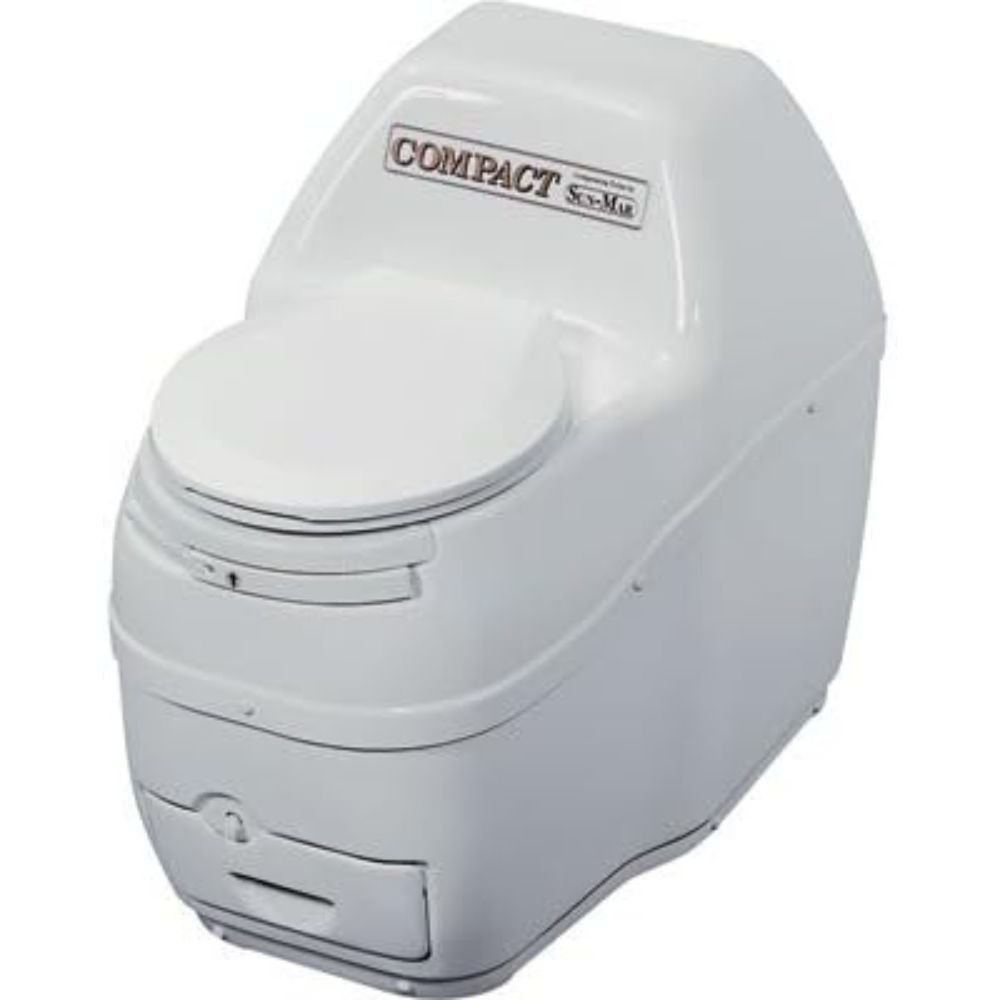
The Sun-Mar Excel composting toilet stands out for its reliable performance in residential settings. With a design that suits both full-time and seasonal use, it excels in converting human waste into a usable compost pile without the need for a traditional septic system.
Its capacity to handle the demands of up to three adults in a residential setting makes it a suitable option, even for larger families. Furthermore, the Sun-Mar Excel can be a game-changer for those living in tiny houses, where space and sustainability are top priorities.
Key Features
- Bio-Drum Technology: One of the key features of the Sun-Mar Excel composting toilet is its Bio-drum technology, which provides efficient and odorless decomposition, processing waste into compost with a simple turn of a handle.
- Evaporating Chamber: Additionally, the Excel composting toilet boasts an evaporating chamber that aids in the reduction of liquid waste, thereby minimizing maintenance. The unit also incorporates a vent stack that facilitates continuous airflow, enhancing the aerobic breakdown of waste and ensuring that the composting process remains efficient.
- Finishing Drawer: The Sun-Mar Excel is equipped with a unique feature that distinguishes it from other models: a finishing drawer. Once the composting process is complete, the end product can be removed easily and hygienically from this drawer, simplifying the handling of composted material. Moreover, the Excel composting toilet includes a thermostatically controlled heater that maintains the internal temperature, ensuring consistent composting activity regardless of external weather conditions. This is particularly beneficial in colder climates where composting can be challenging.
- Large Capacity: Furthermore, the Sun-Mar Excel can handle x 20 times the load compared to smaller models, making it an ideal choice for households with higher usage rates. Its large capacity means less frequent emptying of the compost, translating to less hassle for homeowners. Additionally, the Excel composting toilet is designed to separate liquids and solids, which enhances the composting process and reduces odor, making it a top-of-the-line choice for those looking to install a composting toilet in their home.
Pros
- High capacity suitable for family use
- Odorless operation through efficient aerobic decomposition
- Easy-to-use with a built-in Bio-drum for simple compost mixing
- Low maintenance with self-contained composting features
Cons
- Higher upfront cost compared to basic models
- Requires electricity to operate the heater and fan
4. Composting Toilet Evo: Compact and Budget-Friendly

The EVO an uncomplicated approach to eco-friendly waste management with its no-frills design. Its simplicity makes it a cost-effective option for those on a budget. The basic structure, you can be flexible on the go without sacrificing comfort, appeals to individuals seeking a straightforward composting solution.
This model is particularly attractive for tiny houses, cabins, or as a temporary setup at a dump station during renovations or camping. The Loveable Loo’s ease of use, combined with its low-cost setup, makes it an accessible choice for many seeking a sustainable toilet system.
Key Features
- Simple Design: The Evo simplicity starts with its design: a sturdy wooden box with a standard toilet seat affixed on top. Underneath, a 1.2 gallons bucket serves as the compost bin, collecting both solids and liquids. This straightforward approach eliminates the need for complex mechanisms, making it user-friendly. Despite its basic structure, the Loveable Loo includes a tight-fitting lid that helps contain odors and a convenient carrying handle, allowing for easy transport to a compost pile or dump station when it’s time to empty the contents.
- Compatible With Biodegradable Liners: Another significant aspect of the Evo is its compatibility with biodegradable liners, which further simplifies cleanup and maintenance. Users have the option to line the 1.2 gallons bucket with compostable bags, making disposal of waste a cleaner process.
- Sturdy & Durable: This toilet not only features a clean design but is also robust, stable, and capable of supporting up to 330 lbs. It is made of recyclable ABS plastic and is resilient and water-resistant.
- Fast Composting Process: The urine container has a capacity of 1.2 gallons, and the solid waste container has a capacity of 1.6 gallons. This provides space for 9 to 11 Number One’s and 6 to 8 Number Two’s – separately emptyable and easy to clean.
Pros
- Extremely affordable and budget-friendly
- Simple design with easy setup and use
- No water or electricity required
- Portable and ideal for off-grid applications
Cons
- Manual emptying and maintenance required
- Less sophisticated odor control
5. Trelino Evo: Best Non-Electric Option
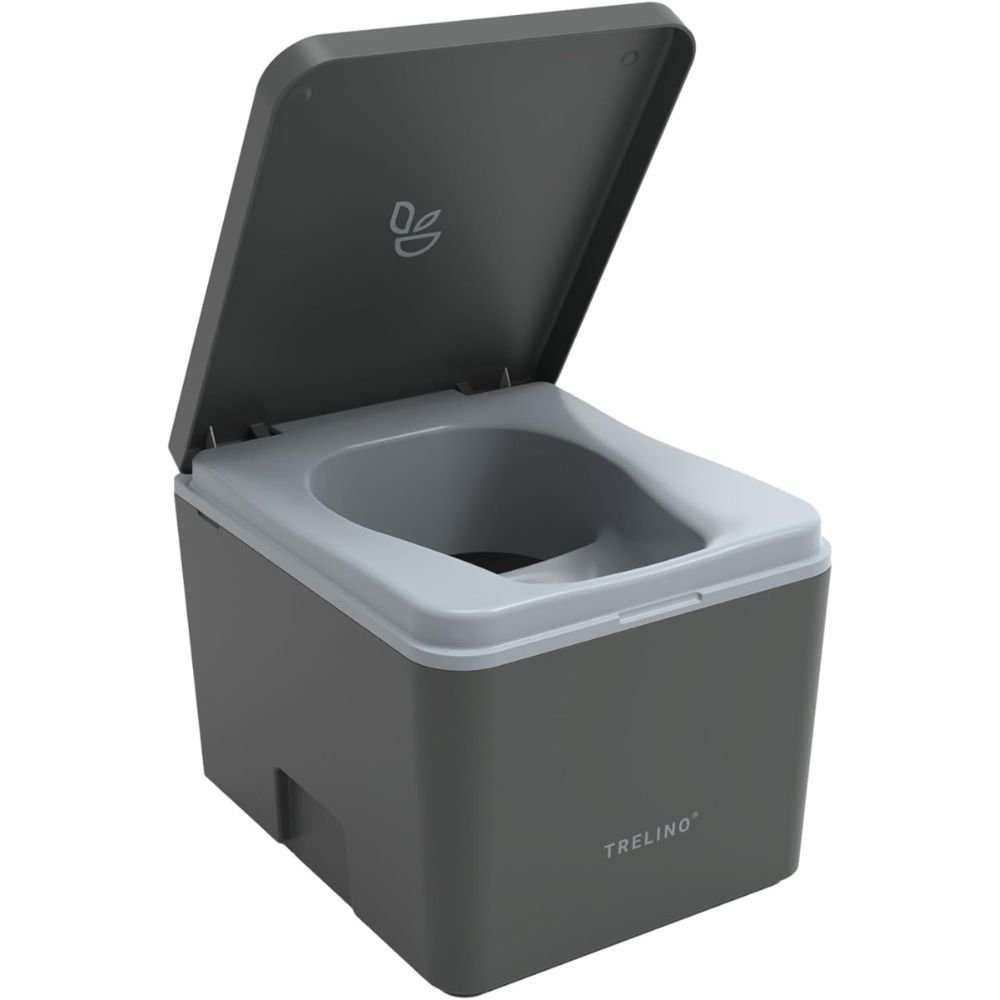
The Trelino Evo stands out as a premier non-electric composting toilet, offering an ideal solution for those looking to reduce their environmental footprint without sacrificing modern comfort. Its sleek design and user-friendly features make it a top contender for off-grid homes, tiny houses, and sustainable living enthusiasts.
The Trelino Evo’s ability to operate without electricity means it can be used virtually anywhere, from remote cabins to eco-friendly festivals, providing a dependable and low-impact sanitation option.
Key Features
- Innovative Feature: Key to the Trelino Evo’s design is its innovative urine-separating feature, which diverts liquids away from solids, significantly reducing odor and making the composting process more efficient. This separation also decreases the volume of waste, meaning the composting toilet can go longer periods without needing to be emptied.
- Lightweight Build: Another standout feature is its compact and lightweight build, which makes the Trelino Evo not only easy to install but also portable, a significant advantage for those who move frequently or want to use it in multiple locations.
- High-Quality Materials: With sustainability at its core, the Trelino Evo is constructed from high-quality, recyclable materials, ensuring that it remains eco-friendly from production to disposal. The unit includes a built-in fan powered by a small solar panel, providing the necessary ventilation to expedite the drying process and further control odors without the need for electrical hookups. Additionally, the Trelino Evo boasts a contemporary design that blends seamlessly into any modern bathroom setting, challenging the notion that composting toilets can’t be both functional and stylish.
- Easy Maintenance Routine: The Trelino Evo also features a simple and straightforward maintenance routine. The solids container is equipped with a compostable liner, which can be tied off and removed with ease when full. The liquid bottle is similarly easy to detach and empty, ensuring that the handling of waste is as hygienic and uncomplicated as possible. These user-centric design considerations underscore the Trelino Evo’s position as a leading non-electric composting toilet in the market.
Pros
- Non-electric operation is ideal for off-grid living
- Urine-separating design for reduced odor
- Lightweight and portable for versatile use
- Constructed from eco-friendly, recyclable materials
Cons
- Limited capacity compared to larger units
- Requires regular emptying of urine bottle
6. OGO™ Compost Toilet – Best Nature Toilet

For those who wants to get close to nature, the OGO™ Compost Toilet offer an easy entry point. These toilet systems are designed with the nature in mind, featuring user-friendly controls and an intuitive design that demystifies the composting process.
Ideal for tiny houses, cabins, and eco-conscious households, the OGO composting toilet fits seamlessly into various living spaces. Its LED indicator provides a clear signal when the composting chamber needs attention, simplifying maintenance for users unfamiliar with composting toilets.
Key Features
- Automatic Mix Function: The BioLet composting toilet is distinguished by its automatic mix function, which ensures that peat moss and waste are blended effectively in the composting chamber after each use. This self-contained composting toilet also incorporates a trap door design that keeps the composting process discrete, all while maintaining a clean and odor-free bathroom environment.
- No Smell: The separation function effectively prevents the formation of odors. By avoiding chemicals and water, you are also independent of dump stations.
- Hygenic: Removable solids bin and urine bottle make it easy to empty and clean. Waste capacity for solids waste is 25-30 uses and bottle holds 2.4 gallons of liquid..
- Versatile: The BioLet is designed to operate without a septic tank, which is particularly beneficial for locations where installing a traditional septic system is not feasible or too costly. Furthermore, the unit can connect to a power source such as a solar panel, making it versatile for various living arrangements, including those in tiny houses or remote locations.
Pros
- Trap door machanism
- Electric agitator
- Liquid level light
- Modern & sleek design
Cons
- Higher initial cost compared to other models
- May require frequent emptying with heavy use
7. Air Head Composting Toilet– Best Energy Consumption Option
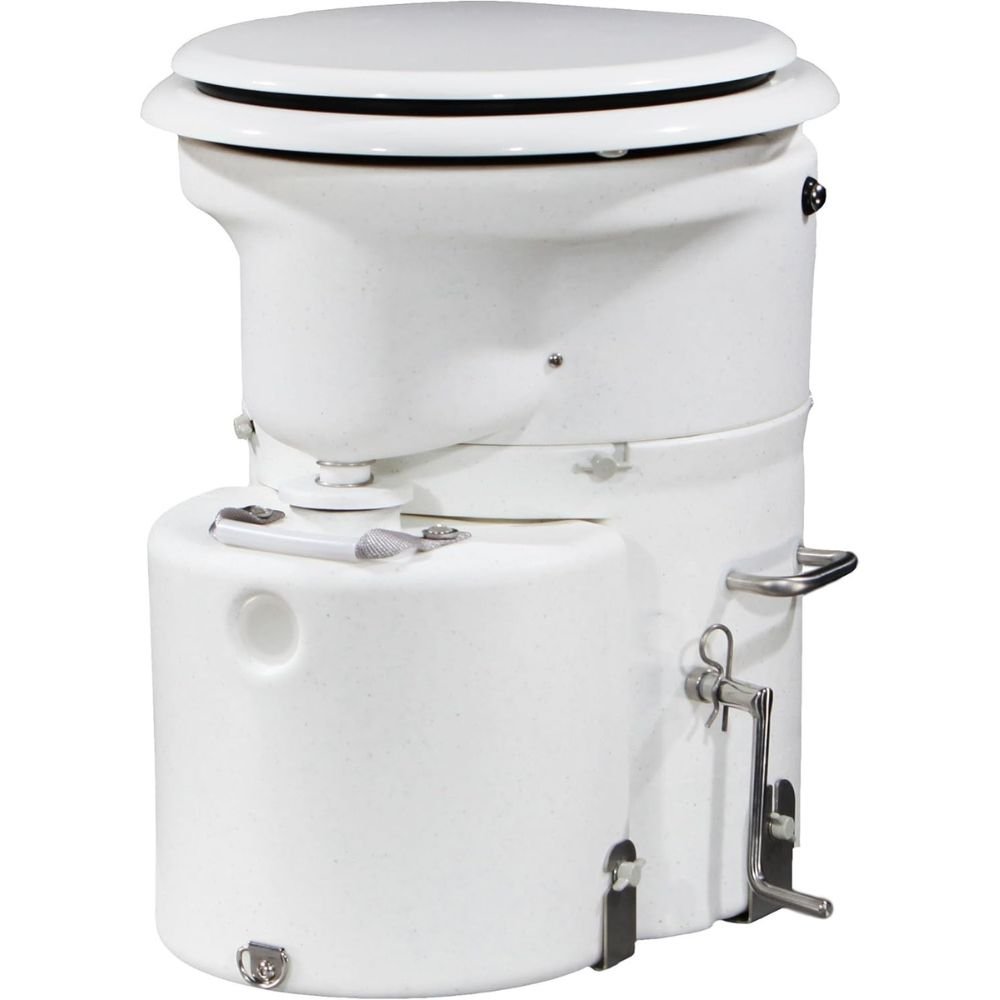
The Air Head Composting Toilet is recognized for its low energy consumption, making it a sustainable choice for those mindful of their ecological footprint. This compact composting toilet is designed to be energy-efficient and suitable for various settings, from boats to tiny homes.
Key Features
- Waterless Toilet System: One of the quintessential key features of the Air Head Composting Toilet is its waterless toilet system, which conserves water and reduces the need for a plumbing infrastructure. It also includes a built-in fan with a low-wattage heating element, ensuring optimal composting conditions.
- Compact Design: The compact design is particularly suitable for small spaces, making it a favorite for tiny houses and RVs. Additionally, this model is equipped with an emergency drain, offering peace of mind in case of any unexpected liquid overflow.
- Ease of Use: Another notable feature is the ease with which users can mix solids to promote composting, thanks to a user-friendly handle. To empty the liquids, the front bottle is detachable, simplifying the maintenance process.
- Straightforward Maintenance: Air head’s composting toilet also references the Humanure Handbook, indicating that this product aligns with well-established humanure principles, which are designed to safely recycle human waste into usable compost.
Pros
- Low power consumption suitable for solar-powered setups
- Easy to install and user-friendly
- Durable design for long-term use
- Separate compartments for liquids and solids to facilitate easy disposal
Cons
- Smaller capacity requires more frequent emptying
- Price point may be higher than other compostable toilet options
Selecting the Perfect Composting Toilet for Your Needs
When selecting a composting toilet, it’s crucial to consider the potential for sewage smell. A well-designed system should effectively manage and minimize any odors, ensuring a pleasant and hygienic environment. It’s one of the key factors that can make or break the practicality and comfort level of using a composting toilet in your daily life.
1. The Composting Toilet Type
Composting toilets come in various types, each suited to different needs and preferences. Central systems, which are similar to traditional toilets, connect to a separate composting unit, often located below the bathroom or outside.
Self-contained units, on the other hand, house the composting chamber within the toilet itself, making them ideal for smaller spaces. The choice between these types depends on your available space, the complexity of installation you’re willing to undertake, and the volume of waste you need to manage.
For those with larger households or frequent usage, a central composting system may be more appropriate, as they typically have a larger capacity. Conversely, if you’re a single person or have a tiny home, a self-contained unit may suffice. It’s important to assess your situation carefully to ensure you choose a composting toilet that aligns with your lifestyle.
2. Mobility and Travel
If you’re someone who loves to travel or live a nomadic lifestyle, mobility is a key consideration when selecting a composting toilet. Portable composting toilets are designed for ease of transport and are ideal for RVs, boats, and tiny houses on the move. They often have features like lightweight construction and secure latches to prevent spills during transit.
For those who frequently change locations, it’s also important to consider the ease of setting up and breaking down the toilet. Models designed with quick-connect features can save time and hassle, allowing you to focus more on your adventures and less on toilet logistics.
3. Climate Considerations
Climate plays a significant role in the functioning of a composting toilet. Cold temperatures can slow down the microbial activity necessary for the composting process, while excessive heat can lead to increased odor and moisture issues.
When choosing a composting toilet, it’s important to consider whether it will be used in a consistently hot, cold, or temperate climate and select a model designed to operate effectively in those conditions.
Some composting toilets are insulated or have built-in heating elements to maintain optimal composting temperatures. If you live in a colder region, these features can be particularly beneficial to ensure the year-round efficiency of your compost pile.
4. Local Regulations
Before investing in a composting toilet, you should be aware of local regulations that may affect your ability to install and use such a system. Some areas have strict guidelines on the treatment and disposal of human waste, and not all toilet systems may be compliant.
It’s essential to do your research and ensure that the system you’re considering meets all necessary codes and standards. In some cases, special permits may be required, or there may be restrictions on the use of composted material. Understanding these regulations upfront can save you from future legal complications and help you make an informed decision.
5. Footprint or Size of the System
The physical footprint or size of the composting toilet system is a crucial consideration, especially for those with limited space. In tiny houses, for example, every inch counts, and a compact toilet system can make a significant difference in the overall livability of the space.
When evaluating the size, consider both the dimensions of the toilet itself and any external components, such as the composting chamber or vent hose. For self-contained units, the entire system is typically enclosed within the toilet, which can be ideal for spaces measuring 28 inches or less in width.
Central systems may require more space but are often suitable for larger homes or permanent installations. If you’re considering a model like the 1000 composting toilet, ensure that it fits comfortably in your intended space without impeding movement or functionality.
6. Ease of Installation and Maintenance
Choosing a composting toilet also involves considering the ease of installation and maintenance. Some models are designed for simple, do-it-yourself installation, while others may require professional assistance. A key component in the installation is the vent hose, which ensures proper airflow and odor control.
Make sure the model you choose comes with clear instructions and manageable installation steps. Maintenance requirements vary between models, with some needing more frequent attention than others.
To avoid unpleasant surprises, understand the maintenance schedule and whether you are comfortable performing the necessary tasks, such as emptying compost or cleaning vents.
7. Smell
One of the most common concerns about composting toilets is the potential for unpleasant smells. A well-designed system should contain and eliminate odors effectively, but this can vary between models. Look for features like tight seals, adequate ventilation, and proper composting mediums that help control and minimize any sewage smell.
Regular maintenance, including adding bulking materials and turning the compost, also plays a significant role in managing odors. It’s important to choose a toilet that makes these tasks as straightforward as possible to ensure a consistently odor-free experience.
8. Price
Composting toilets can range in price from a few hundred to several thousand dollars. While budget-friendly options may appeal to your wallet, consider the long-term value of investing in a higher-quality model that may offer better durability and lower maintenance costs.
Factor in the potential savings on water and sewage bills, and you might find that a higher initial investment can lead to significant financial benefits over time, making it a worthy consideration when selecting your composting toilet.
Maintenance Tips for a Composting Toilet
To maintain a composting toilet, regular monitoring and upkeep are essential. Start by ensuring the balance of carbon-rich materials, like sawdust or peat moss, with nitrogen-rich human waste to support proper composting. Adequate ventilation is also crucial; check that the vent hose is clear and functioning to prevent any build-up of gasses or odors.
Empty the composting chamber according to the manufacturer’s guidelines to prevent overfilling, which can lead to odor issues and reduced efficiency. When emptying, wear gloves and take care to avoid contamination. Afterward, clean the area thoroughly to maintain hygiene standards.
Additionally, keep an eye on the moisture level within the composting chamber. Excess moisture can impede the composting process and lead to odors, so add more carbon-rich material if the compost appears too wet. Conversely, if it’s too dry, add a small amount of water to maintain the necessary moisture balance.
Frequently Asked Questions About Composting Toilets
1. How does a composting toilet work?
These systems are designed to maximize airflow and create an environment conducive to aerobic decomposition, which helps break down the waste efficiently without unpleasant odors. By replicating and optimizing natural processes, composting toilets turn what would be sewage into a beneficial product, all while conserving water and reducing pollution.
2. Can you use toilet paper in a composting toilet?
Yes, you can use toilet paper in a composting toilet. These toilets utilize a combination of organic materials, like sawdust or coconut coir, to aid in the composting process. When you add toilet paper, it’s broken down together with the waste into nutrient-rich compost. Most models feature a crank to mix the composting material and toilet paper into the solids bin, which helps distribute moisture and accelerate decomposition.
3. Will you have to deal with worms, flies, and other bugs in your composting toilet?
Composting toilets are designed to minimize the presence of pests like worms, flies, and other bugs. By maintaining the correct balance of carbon-rich materials and ensuring proper ventilation, these systems can prevent the conditions that attract these critters. Regular maintenance and following the manufacturer’s guidelines for your specific toilet model are key to preventing infestations.
However, if the composting process is not managed correctly, there is a potential for bugs to be attracted to the waste. In such cases, troubleshooting measures like adjusting moisture levels or adding more carbon-rich materials can solve the problem. Overall, with attentive care, the presence of pests in a composting toilet is not a common issue.
4. How do you clean a composting toilet?
Cleaning a composting toilet is a straightforward process. Composting toilet users should start by removing any visible debris from the toilet seat and surrounding areas. For the toilet seat, a gentle, environmentally-friendly cleaner can be used to wipe down the surface. It’s important to avoid using harsh chemicals that could disrupt the composting process or harm the beneficial bacteria within the system.
Inside, the composting chamber should be monitored to ensure the toilet stays at the correct composting consistency. It’s occasionally necessary to add more carbon-rich cover material to maintain the balance. Additionally, the liquid container should be emptied regularly and cleaned with a mild detergent to prevent odors and maintain hygiene. With these simple practices, your composting toilet can remain clean and odor-free.
5. Can you compost other organic materials in the toilet?
While primarily designed for human waste, some models of composting toilets can handle additional organic materials. Items like vegetable peels and fruit scraps are generally safe to add, but it’s important to avoid meats, dairy, and oily foods, which can attract pests and cause odors. Additionally, you’ll need to manage the liquid container carefully, as excess moisture from kitchen waste can alter the composting environment.
6. What composting toilet is right for me?
Choosing the right composting toilet for your needs depends on several factors. Consider the number of users, the location where the toilet will be installed, and whether the unit will be used occasionally or full-time. If you’re off-grid or have limited access to water, a self-contained unit with a high capacity for solids might be best. For those with more frequent access to disposal sites or who travel often, a smaller, portable unit could be more suitable.
Additionally, take into account the ease of installation, maintenance requirements, and any local regulations regarding waste disposal. Researching different models and reading user reviews can also be helpful in making your decision. Ultimately, the best composting toilet for you is one that fits your lifestyle, environmental goals, and budget while providing reliable and sanitary waste management.
Final Insights on Making the Green Switch
Embarking on the journey to embrace the best composting toilets represents a significant stride toward sustainability. Compared to traditional flush toilets, they offer a practical solution to reduce water usage and environmental impact.
For those seeking to incorporate a toilet in your RV or are perhaps a solo traveler, an RV composting toilet can be a game-changer, affording you the freedom of off-grid living without compromising on personal hygiene. Understanding that composting toilets, especially top-tier dry toilets, are designed to offer both convenience and eco-efficiency can help ease the transition from conventional to composting systems.
However, it’s vital to acknowledge a couple of challenges you might face with this green technology. The initial cost of installation may be higher than standard options and regular emptying and compost management are required.
Ultimately, the decision to switch lies in weighing these considerations against the long-term benefits and the positive environmental footprint you will leave within the United States and beyond.

